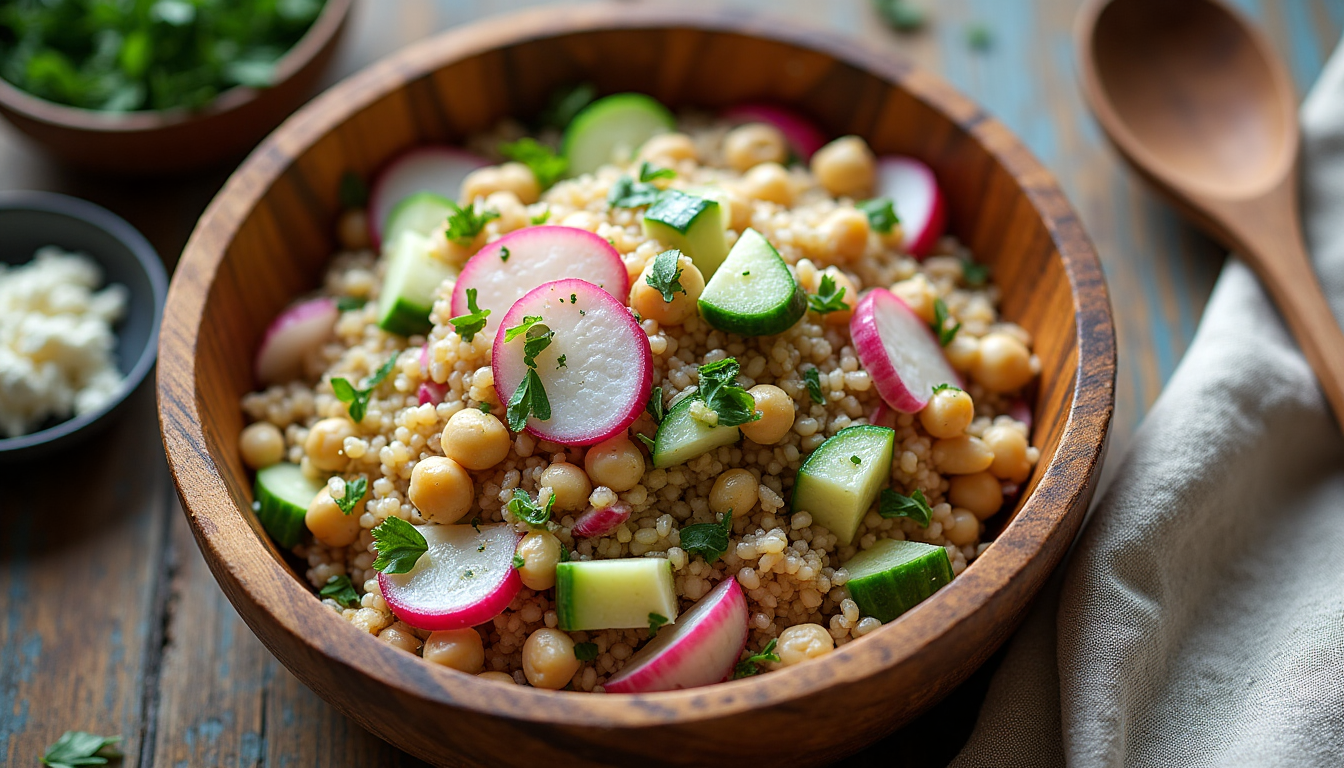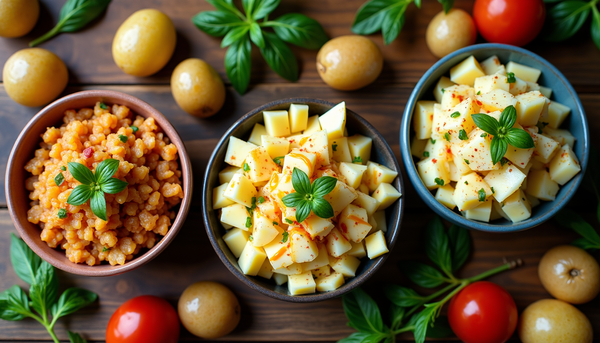Why I'm Obsessed with This Messy Spring Farro Salad

Okay, confession time. Last week I impulse-bought three bunches of radishes at the farmers market because they looked so darn pretty. Then I promptly let two of them wilt in my crisper drawer while I ordered takeout twice and ate cereal for dinner once.
Anyone else live this seasonal eating contradiction? We want to embrace spring's bounty, but real life keeps happening.
This is exactly why I've become borderline obsessed with grain salads – specifically this spring farro situation that's been on repeat in my kitchen. It's like the Swiss Army knife of seasonal cooking: flexible enough for whatever vegetables you actually remembered to buy, sturdy enough to survive your chaotic week, and satisfying enough that you won't be raiding the snack cabinet an hour later.
Why Farro Gets It
Let's talk about farro for a second. If quinoa is the overachiever who always has their life together, farro is the reliable friend who shows up with wine when you need them. It's got this nutty, almost earthy flavor that doesn't try too hard, and a chewy texture that actually makes you feel like you're eating something substantial.
I used to be intimidated by ancient grains (anyone else feel like they needed a PhD in nutrition just to shop for dinner?), but farro is surprisingly forgiving. Overcook it a little? Still good. Undercook it slightly? Also fine. It's the kind of ingredient that works with your skill level, not against it.
The best part? It gets better as it sits. While your lettuce-based salads are wilting and getting soggy, farro salad is in the fridge getting its life together, soaking up flavors and staying perfectly textured for days.
Embracing "Good Enough" Seasonal Cooking
Here's what I've learned about seasonal eating: it doesn't have to be perfect to be meaningful. You don't need to nail every farmers market ingredient or plan meals around what's "peak season" if that stress is taking the joy out of cooking.
This spring farro salad embodies what I call "good enough" seasonal cooking. Got cucumbers? Toss them in. Radishes looking sad? They'll perk up with some salt and acid. That bunch of herbs you bought with good intentions? Perfect, even if half of it's questionable.
The recipe I'm about to share came from one of those "what's in my fridge" moments when I needed to use up vegetables before they became expensive compost. Sometimes the best recipes aren't born from carefully planned shopping lists – they come from necessity and a willingness to experiment.
The Recipe (With Real Talk)
The Base:
- 1 cup uncooked farro (I use whatever's cheapest, honestly)
- 1 can chickpeas, drained (sometimes I forget to rinse them, world doesn't end)
- 4 oz feta cheese, crumbled (or however much feels right)
The Spring Stuff:
- 4 Persian cucumbers, sliced thin (regular cucumbers work fine too)
- 4 radishes, sliced (use what you have, even if they're a bit soft)
- 1 shallot, minced (or half a regular onion if that's what's available)
- 1/4 cup fresh dill, chopped
- 1/4 cup fresh mint, chopped
The Magic Sauce:
- 3 tablespoons olive oil
- 2 tablespoons lemon juice (fresh is better, but bottled works)
- 1 teaspoon Dijon mustard
- 1 garlic clove, minced
- Salt and pepper to taste
The process is almost embarrassingly simple. Cook your farro according to package directions – usually around 20-30 minutes in boiling salted water until it's tender but still has some bite. While that's happening, chop your vegetables. I'm not precious about perfect dice here; rustic chunks are perfectly fine.
Make your dressing by whisking everything together. Taste it. Adjust it. More lemon if you like tang, more salt if it tastes flat, more oil if it's too sharp. Cooking is supposed to be intuitive, not rigid.
Once your farro is done, drain it and rinse with cold water to cool it down quickly. Then just toss everything together in a big bowl. The beauty is in how forgiving this whole process is.
Making It Work for Your Life
Here's where this recipe really shines – in its flexibility. Don't have feta? Try goat cheese or just skip it entirely. No fresh herbs? Dried ones work, just use less. Hate radishes? Swap in snap peas or carrots or whatever makes you happy.
I've made versions with leftover roasted vegetables, added different beans when I was out of chickpeas, and thrown in whatever greens needed to be used up. My kids actually prefer it with cherry tomatoes instead of radishes, and my partner likes it with added avocado (though that means eating it faster).
The gluten-free folks in my life make this with quinoa or rice. The vegans skip the cheese and nobody misses it. That's the kind of recipe flexibility that actually works in real kitchens with real dietary needs and preferences.
The Honest Truth About Meal Prep
Food bloggers love to talk about how grain salads are "perfect for meal prep," and while that's true, let me give you the real story. Yes, this keeps well for about 3-4 days in the fridge. Yes, the flavors improve over time. But by day four, you might be sick of eating the same thing.
My solution? Make a big batch on Sunday, but dress half of it immediately and keep the other half plain. Then you can turn the undressed portion into different meals throughout the week – add it to soup, stuff it in a wrap, or mix it with different vegetables and dressing for variety.
Also, if you're planning to pack this for work lunches, pack the dressing separately for the first day or two. Nobody wants soggy farro salad at 1 PM on a Tuesday.
Storage Reality Check
Let's be honest about leftovers. This salad tastes best on day one and two. Day three is still pretty good. Day four is when you start questioning your meal planning skills, and day five is probably pushing it unless you've been really good about proper storage.
Keep it in an airtight container, and maybe pack some extra herbs or a squeeze of fresh lemon to brighten it up if it starts tasting a bit flat. Sometimes I'll add a handful of fresh greens right before eating to give it some textural contrast.
Why This Matters
I think there's something quietly radical about making space for imperfect seasonal eating. We're constantly bombarded with images of pristine farmers market hauls and perfectly composed grain bowls, but that's not how most of us actually cook and eat.
This farro salad represents something more realistic: using what's available, adapting to what you have, and finding satisfaction in simple combinations that work. It's seasonal cooking for people who sometimes buy pre-cut vegetables and don't always have time to properly meal plan.
Spring doesn't last forever, and neither does the perfect asparagus or the tender lettuce. But having a few flexible recipes in your back pocket means you can capture some of that seasonal joy without the pressure of doing it perfectly.
The radishes I bought last week? I finally used them in this salad on Thursday, even though they weren't quite as crisp as they could have been. The salad was still delicious, and I felt that little spark of satisfaction that comes from using ingredients seasonally, even imperfectly.
Sometimes good enough really is good enough. And sometimes that's exactly what we need to keep cooking, keep trying, and keep finding joy in feeding ourselves well, whatever that looks like in the context of our actual lives.
Make this salad. Adapt it. Use up those vegetables that are calling to you from the farmers market or sitting hopefully in your crisper drawer. Spring is here, and it doesn't require perfection – just a willingness to embrace what's available and make something nourishing from it.




